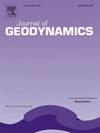The slab gap-related Late Cretaceous-Paleocene magmatism of southern Patagonia
Abstract
The only Late Cretaceous-Paleocene intraplate magmatic unit of southern Patagonia, known as the Las Mercedes basalt, is petrogenetically studied in its geodynamic context. The outcrops of this unit are thin ridges located in a narrow 50 km wide latitudinal strip (∼48 °S) of the central region of the Deseado Massif, generated by pahoeoe-type lava flows that probably covered large ancient streams and rivers. Compositionally the rocks are metaluminous basanites and alkaline and subalkaline basalts uninfluenced by slab-derived components with Mg# ranging from 53.9–65. The origin of this intraplate igneous manifestation would have been related to the opening of a Late Cretaceous-Paleocene trench-perpendicular slab tear of the Aluk subducting plate. This event induced the decompression melting of the sub-slab silica-deficient garnet pyroxenite asthenosphere causing the extrusion of a discrete volume of basalts. The slab anisotropy was generated by the slab-dip change in a transition region from a flattened sector (north of ∼48 °S) related to a large flat-slab (Nalé flat-slab) to one with steeper subduction angle (south of ∼48 °S). Also, this slab tearing would be responsible for the anomalous occurrence of intraplate magmatism located in the same latitudinal strip of the Las Mercedes basalt but in the Andean magmatic arc region, which together represent the only Late Cretaceous igneous activity unrelated to the magmatic arc in central-southern Patagonia and southern Andean region.

 求助内容:
求助内容: 应助结果提醒方式:
应助结果提醒方式:


